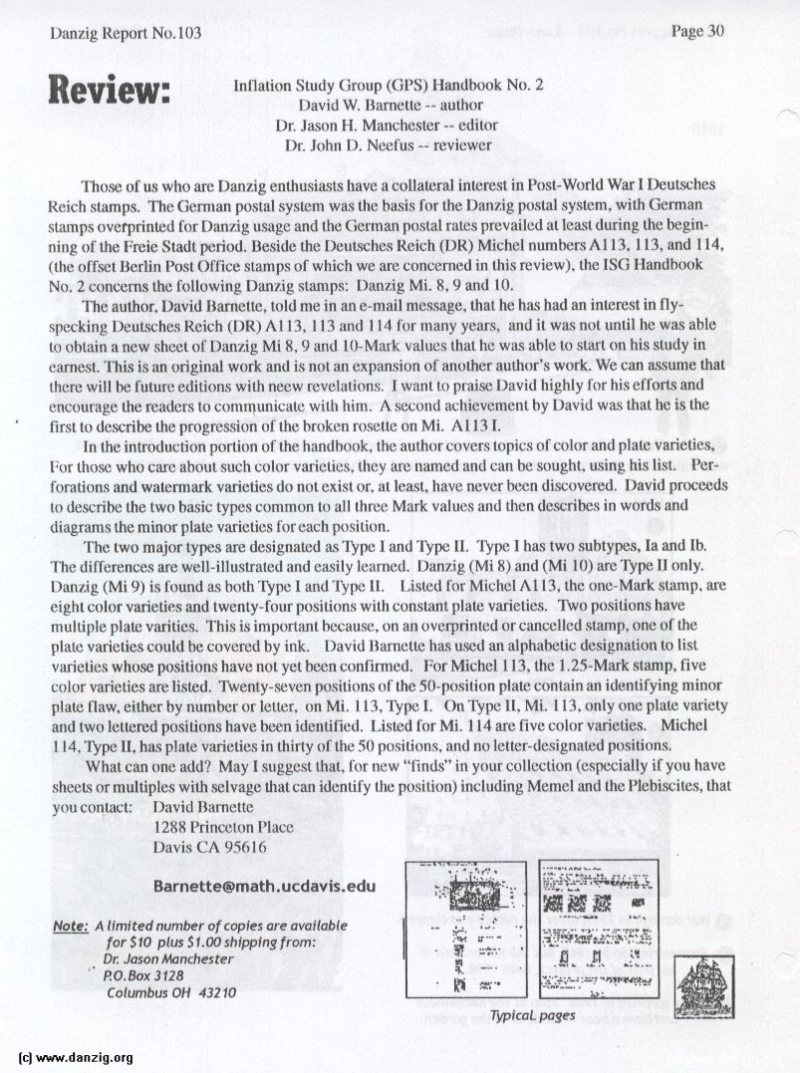
Review
Inflation Study Group (GPS) Handbook No. 2
David W. Barnette -- author
Dr. Jason H. Manchester -- editor
Dr. John D. Neefus -- reviewer
Those of us who are Danzig enthusiasts have a collateral interest in Post-World War I Deutsches Reich stamps. The (Jenuan postal system was the basis for the Danzig postal system, with German stamps overprinted for L)ani’.ig usage and the German postal rates prevailed at least during the beginning of the Freic Stadt period. Beside the 1)eut.sches Reich (1)K) Michel numbers Al 13. 113, and 114. (the offset Berlin Post Office stamps of which we are concerned in this review), the 15(1 Handbook No. 2 concerns the following Daniig stamps: Danzig Mi. 8.9 and 10.
The author. David Barnette, told me in an e-mail message, that he has had an interest in flys pecking I )eutschcs Reich (I )R) A 113. 113 and I 14 for many years. and it was not until he was able to obtain a new sheet ol l)aniig Mi 8, 9 and lO-Maik values that he was able to start on his study in earnest. iliis is an original work and is not an expansion of another author’s work. We can assume that there will be future editions with neew revelations. I want to praise l)avid highly for his efforts and encourage the readers to communicate with him. A second achievement by L)avid was that he is the first to dcscnhe the progression of the broken rosette on Mi. A 113 1.
In the introduction portion of the handbook, the author covers topics of color and plate varieties, For those who care about such color varieties, they are named and can be sought. using his list. Perf orations and watermark varieties do not exist or, at least, have never been discovered. David proceeds to describe the two basic types common to all three Mark values and then describes in words and diagrams the minor plate varieties for each position.
The two major types are designated as ype I and Type II. Type I has two suhtypc.s. Ia and lb. The differences are well-illustrated and easily learned. l)anzig (MI K) and (Mi 10) arc Type II only. 1)ani.ig (Mi 9) is found as both Type I and Type II. Listed for Michel Al 13. the one-Mark stamp, are eight color varieties and twenty-four positions with constant plate varieties. Two positions have multiple plate varities. This is important because, on an overprinted or cancelled stamp, one of the plate varieties could be covered by ink. l)avid Ilarnette has used an alphabetic designation to list varieties whose positions have not yet been confirmed. For Michel 113. the 1.25-Mark stamp. five color varieties are listed. Twenty-seven position.s of the 50-position plate contain an identifying minor plate flaw, either by number or letter, on Mi. 113, Type I. (in Type II. Mi. 113, only one plate variety and two lettered positions have been identified, listed for Mi. 114 are five color varieties. Michel 114. Type 11, has plate varieties in thirty of the 50 positions, and no letter-designated positions.
What can one add? May I suggest that, for new “finds” in your collection (especially if you have sheeLs or multiples with selvage that can identify the position) including Memel and the Plebiscites, that you contact:
Danzig Report Vol. 1 - Nr. 103 - April - May - June - 1999, Page 33.
Hits: 3788
Added: 25/07/2015
Copyright: 2025 Danzig.org

